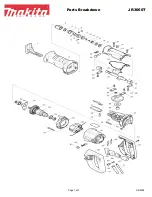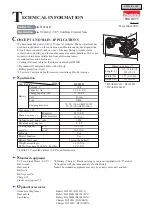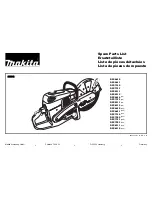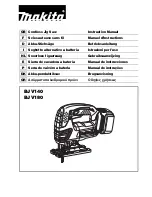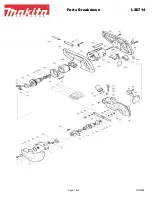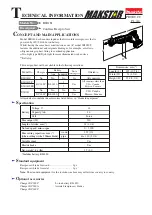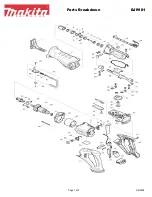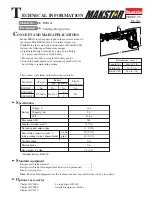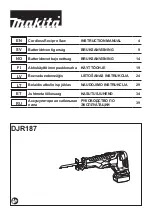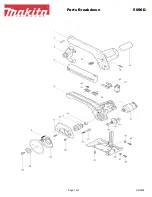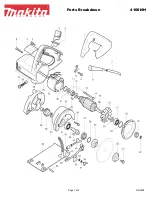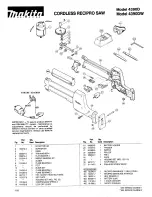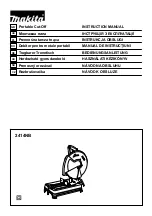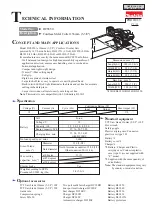
12
! never pull tool backwards
• Cutting large panels
u
-
support panel close to the cut either on floor, table or
workbench
! set cutting depth so that you cut through panel
and not through support
-
in case parallel guide does not allow desired width of
cut, clamp or nail straight piece of wood to workpiece
as a guide, and use the left side of the foot against this
guide
i
• For more information see www.skil.com
MAINTENANCE / SERVICE
• This tool is not intended for professional use
• Always keep tool clean (especially ventilation slots N )
! remove battery from tool before cleaning
• Always keep the area around lower guard W
2
clean
(remove dust and chips by blowing out with compressed
air or with a brush)
• Clean saw blade immediately after use (especially from
resin and glue)
• If the tool should fail despite the care taken in
manufacturing and testing procedures, repair should
be carried out by an after-sales service centre for SKIL
power tools
-
send the tool undismantled together with proof of
purchase to your dealer or the nearest SKIL service
station (addresses as well as the service diagram of the
tool are listed on www.skil.com)
• Be aware that damage due to overload or improper
handling of the tool will be excluded from the warranty
(for the SKIL warranty conditions see www.skil.com or
ask your dealer)
ENVIRONMENT
• Do not dispose of electric tools, batteries, accessories
and packaging together with household
waste material
(only for EU countries)
-
in observance of European Directive 2012/19/EC
on waste of electric and electronic equipment and
its implementation in accordance with national law,
electric tools that have reached the end of their life
must be collected separately and returned to an
environmentally compatible recycling facility
-
symbol
6
will remind you of this when the need for
disposing occurs
! prior to disposal protect battery terminals with
heavy tape to prevent short-circuit
NOISE / VIBRATION
• Measured in accordance with EN 62841 the sound
pressure level of this tool is 96 dB(A) and the sound
power level 107 dB(A) (uncertainty K = 3 dB), and the
vibration
Þ
(triax vector sum; uncertainty K = 1.5 m/s²)
✱
cutting wood < 2.5 m/s²
✱
cutting metal < 2.5 m/s
2
• The vibration emission level has been measured in
accordance with a standardised test given in EN 62841;
it may be used to compare one tool with another and as
a preliminary assessment of exposure to vibration when
using the tool for the applications mentioned
-
using the tool for different applications, or with different
• Dust suction
e
For using vacuum cleaner
-
connect vacuum cleaner hose to vacuum cleaner
adapter H
! never let the vacuum cleaner hose interfere with
the lower guard or the cutting operation
! do not use vacuum cleaner when cutting metal
• Operating the tool
-
mount battery
-
always hold handle C firmly
-
place tool with front end of foot flat on workpiece
! ensure that the saw teeth are not engaged into the
workpiece
-
switch on tool by first pressing knob E (= safety switch
which cannot be locked) and then pulling trigger D
! the tool should run at full speed before the blade
enters into the workpiece
-
lower guard W opens automatically when saw blade
enters the workpiece (open lower guard manually by
using lever S only for special cuts such as plunge cuts)
! do not force the tool (apply light and continuous
pressure in order to avoid overheating the blade
tips)
! while working, always hold the tool at the grip
area(s)
-
after completing the cut switch off tool by releasing
trigger D
! ensure that the blade has come to a complete
standstill, before you lift the tool from the
workpiece
APPLICATION ADVICE
• Always face the good side of the workpiece down to
ensure minimum splintering ensure minimum splintering
when sawing wood and wood-like materials.
• Sawing performance and cutting quality depend
essentially on the condition and the tooth count of the
saw blade.
• Only use sharp saw blades that are suited for the material
being cut
r
-
use hardened steel saw blade AC
2
for cutting wood,
aluminium, plastic and all sorts of laminated wood
-
use diamond disc AD
2
for cutting ceramics and tiles
-
carbide tipped blades Y
2
stay sharp up to 30 times
longer than ordinary blades
• Parallel guide J
t
-
for making exact cuts along a workpiece edge
-
insert through the slots in the front end of the foot
Adjusting parallel guide
-
loosen screw K using hex key A
-
adjust to desired cutting width by using parallel guide
scale (use line-of-cut indicator L as 0-reference)
-
tighten screw K
• Plunge cutting
y
-
set desired cutting depth
-
tilt tool forward with line-of-cut indicator L lined up with
desired line of cut marked on the workpiece
-
open lower guard W with lever S
-
just before blade enters workpiece, switch on tool and
gradually lower back end of tool using front end of foot
as hinge-point
-
gradually move tool downward as well as forward
-
as soon as blade enters the material, release lever S
Содержание 3540
Страница 5: ...5 3 4 5 6 AB 7 8 9 7a 7b 7c T P Q 3mm ...
Страница 6: ...6 hard hard soft COMPACT 30 45 q r w e t U V H K J Ø35 36mm L ...
Страница 7: ...7 ACCESSORIES WWW SKIL COM y u i L S ...
Страница 184: ...184 WWW SKIL COM y u i L S ...
Страница 185: ...185 hard hard soft COMPACT 30 45 q r w e t U V H K J Ø35 36mm L ...
Страница 186: ...186 3 4 5 6 AB 7 8 9 7a 7b 7c T P Q 3mm ...




























